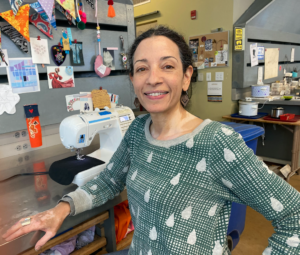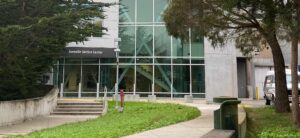Over the past few weeks, morning and night, a huge construction crane has been visible from Lick-Wilmerding’s campus. Balboa Park Upper Yard (BPUY) in District 11 is in the process of being transformed into over 100 units of affordable housing for families.
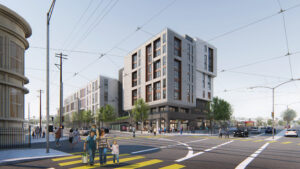
photo courtesy of Iveanette Santiago Rivera
2340 San Jose Avenue in San Francisco was previously a SFMTA parking lot for rail cars. Then it became a parking lot for SFMTA employees. More recently, it has been utilized for positive community action as a resource for the community. Even in the time between the proposal of the project and the start of construction it was used as a resource for low-income residents as a vehicle triage site.
The proposed idea is to build 131 affordable housing units, retail space, community service space and a childcare center. The plan still includes a minimal number of parking spaces for cars and 113 bike parking spots for residents.
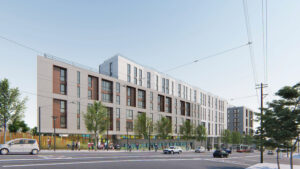
photo courtesy of Iveanette Santiago Rivera
This BPUY affordable housing project has been in the works since 2008. It was proposed by People Organizing to Demand Environmental & Economic Rights (PODER), a San Francisco based organization whose mission is to empower Latinx families and youth.
PODER began by creating a neighborhood group of local organizations called Communities United for Health and Justice (CUHJ) to work on this project.
The CUHJ is made up of five local organizations: Coleman Advocates for Children & Youth, the Filipino Community Center, PODER, Bernal Heights Neighborhood Center and Chinese for Affirmative Action.
The initial report developed by CUHJ addressed the issue of raising eviction rates, especially for families, and more expensive luxury housing being built instead of affordable homes.
The document stated the goal of the project: to create 100% affordable homes. It also shared survey results that confirmed that residents of District 11 were in support of the project and wanted members of the community to be involved in the planning process.
The CUHJ created a set of recommendations for whoever was to develop the project. They included a suggested application and screening process for potential residents, how to make it affordable, what kinds of facilities would best suit the community’s needs, how to include the community in the planning process and ways to keep their livelihood and safety a top priority.
The project is funded primarily by the city with a budget of about 120 million dollars.
Construction on the lot began in July of 2021 and is expected to go on for a total of 24 months. Mission Housing Development Corporation and Related California are the organizations developing the BPUY Affordable Housing Project.
Mission Housing Development Corporation is a local nonprofit whose mission is to develop “high-quality, well-managed, affordable, sustainable homes and communities that promote the self-sufficiency of low and moderate-income families, seniors, and persons with diverse needs,” according to their website. They manage 35 buildings in the city and are working on developing many more affordable housing and rental units.
Sam Moss, the Executive Director of Mission Housing, described his organization’s role in the project: “When the building is done, Mission Housing and one of its subsidiaries will perform the asset and property management,” he said. “We will be the entity that is responsible for performing all kinds of social services. This includes the food pantry, free computer lab, job and health counseling, physical and mental wellbeing, classes on finance and any kind of service you can think of that might be available in affordable housing.”
Related California is a larger statewide real estate firm that more recently expanded to include the Pacific Northwest. They strive to develop quality affordable housing and build community.
According to Andrew Schorfhaar, the Assistant Vice President of Development at Related California, their role in the project is handling the financial side of things. “We’re very involved in the predevelopment prior to the construction — assembling the financing and then playing an active role in overseeing the construction. As far as the long-term ownership, we will remain a partner with Mission Housing for the whole life of the project.”
Affordable housing allows residents of cities that are becoming more expensive to keep living in their neighborhoods. They are already a part of and provides access to the opportunities found within these cities. The idea behind the location of this new development is that it is right next to the Balboa BART station, which makes it a more accessible place to live for low-income residents. The area is also very close to several MUNI lines and Highway 280.
“You really couldn’t pick a much better spot for affordable housing other than the corner of Geneva and San Jose. It’s served by BART, Caltrain and by half a dozen buses, in addition to being a quarter mile from the Ocean Avenue campus that will also have 1500 new homes and 500 new affordable homes at the Balboa Reservoir in the future,” Moss said. The Balboa Reservoir affordable housing site is also being developed by Mission Housing and is located at 11 Phelan Avenue.
BPUY affordable housing is primarily being developed for families, however the developers have a plan to relocate older parents whose children have moved out to other affordable housing complexes in the neighborhood.
Mithun, a Seattle, San Francisco and Los Angeles based design firm, is handling the design and construction of these new residential units.
The lead architect of the project from Mithun, Iveanette Santiago Rivera, described her goal in designing the complex: “Our goal is to balance the need to provide more affordable units, and the desire for a building that fit-in within the neighborhood scale.”
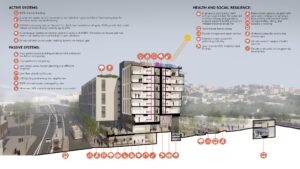
photo courtesy of Iveanette Santiago Rivera
Rivera’s favorite part of the building is the entrance and its fluidity. “The Entry Court is this beautiful, very open space that also provides direct access to the courtyard and lobby,” she said. You can see pretty much everything from there, including a “direct visual connection to the BART plaza,” according to Rivera.
“It’s that interconnectivity between the BART plaza, streets and buildings that people are going to experience. It’s almost like the building becomes a part of the urban fabric (when you walk in) even if only a visual connection,” Rivera said.
The residential area would be 158,050 square feet, the retail area would be 4,000 square feet and office space would be 3,350 square feet.
In the past, District 11 has not had lots of affordable housing available to its residents. The past few district supervisors, including John Avalos and Ahsha Safai, have played a huge role in getting these initiatives going recently.
“Former District 11 Supervisor John Avalos was the one who actually got the funding to do the first survey and got proof that the neighborhood did want affordable housing. Current Supervisor Ahsha Safai has been involved at all levels from the very beginning,” Moss said.
Safai said, “Affordable housing has long been a priority for District 11 residents. However, the process for getting it done needed to be reimagined. We have been able to see success by gaining the financial commitments of our state leaders and the mayor, and also by collaborating with local agencies such as BART.”
Safai has been handling the BPUY Affordable Housing Project on the city’s side. He described the purpose of the project from his eyes: “It provides 100% affordable housing for working families. Our district has more working families (which includes but is not limited to janitors, teachers, firefighters, restaurant workers and nurses) with children than any other district.”
Safai’s overall goal for this new affordable housing is to “preserve the rich cultural history of the neighborhood by allowing families, who otherwise could not afford it, to stay in the neighborhood.”
According to Moss, the project “has a 45% neighborhood preference, so 45% of the units will go to people who live in or have been evicted from District 11.”
Supervisor Safai’s favorite part of the project is the childcare center, and he was heavily involved in making sure it was included in the design for the space. This center will be run by the YMCA and will be open to both residents of the complex and other local families.
Once the construction is closer to complete, BPUY will become open to applications. Most applications for affordable housing in the city exist in one government system, where applicants wait on a list until they are housed somewhere based on their needs. Mission Housing will begin facilitating this process and choosing applicants for their site specifically towards the end of 2022.
BPUY is going to create lots of positive change in District 11. Low-income residents will be able to continue living in their neighborhoods and communities. The atmosphere of the neighborhood and BART plaza will be much more organized and appealing and the site will provide amenities for members of the community. The Balboa Park neighborhood will be transformed into a beautiful and accessible place to live.





